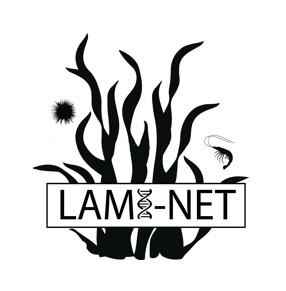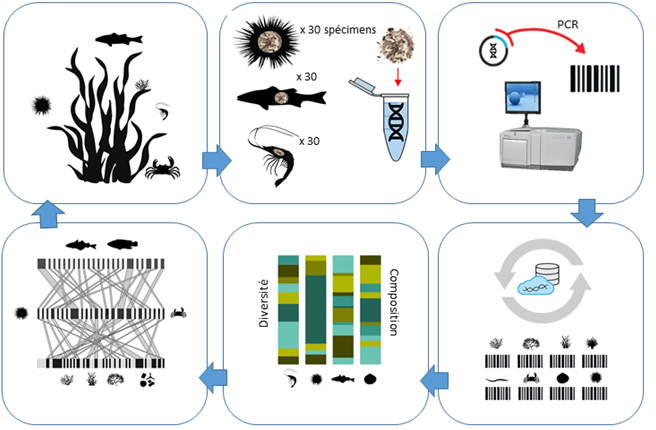
Monitoring marine trophic webs using dietary DNA metabarcoding
(LAMINET 2022-2024)
Collaborations : OFB, Station de Roscoff, Université de Bretagne Occidentale, Station marine de Dinard, Réserve naturelle nationale des Sept-Îles, Parc National Marin d’Iroise.
Research
Context and problematic
Kelp forests are one of the most iconic underwater ecosystems along the Brittany coastline, valued for their ecological, economic, and cultural significance. They support a diverse range of epiphytic algae, meiofauna, and macrofauna species that are important resources for local fisheries.
Globally, these ecosystems are vulnerable to large-scale defoliation events due to a combination of factors such as pollution, overfishing, seaweed harvesting, biological invasions, and temperature anomalies associated with climate change. Mass disappearances of kelp often lead to disruptions in their trophic dynamics, which can have cascading effects on the entire community.

To understand the connections between biodiversity and the functioning of kelp forests, particularly the processes of biotic compensation that promote their long-term resilience and stability, it is essential to understand the interaction networks among species within the communities. Traditional approaches used to determine dietary preferences (isotope analysis, micro-histology of stomach contents) are difficult to implement on a large number of individuals/taxa and lack precision. As a result, there is a lack of data on species that directly or indirectly depend on the detrital fraction of kelp or on secondary consumers (fish, macro invertebrates) that play a role in regulating herbivore populations. In general, there is a lack of functional habitat descriptors to assess the impact of anthropogenic pressures.
Objectives
Part 1 of this project aims to identify trophic interactions among organisms associated with kelp forests (seals, seabirds, fish, invertebrates, and algae) in two marine protected areas (Iroise Marine National Park and Sept Iles National Nature Reserve) by analyzing environmental DNA (eDNA) in feces and stomach contents (dietary eDNA metabarcoding).
Part 2 aims to establish links between the trophic niche of bio-indicator species (e.g., saithe, velvet crab, ballan wrasse, sea urchin), benthic and ichthyological biodiversity, and primary (algae community) and secondary production (fish size and abundance) in kelp forests. For this purpose, we are conducting a comparative study at around a dozen coastal and offshore sites (varying in turbidity and hydrodynamics) in different regions of Brittany. The goal is to develop a trophic indicator for assessing the functional habitat quality in accordance with the requirements of the DCSMM (Marine and Coastal Planning Directive).
